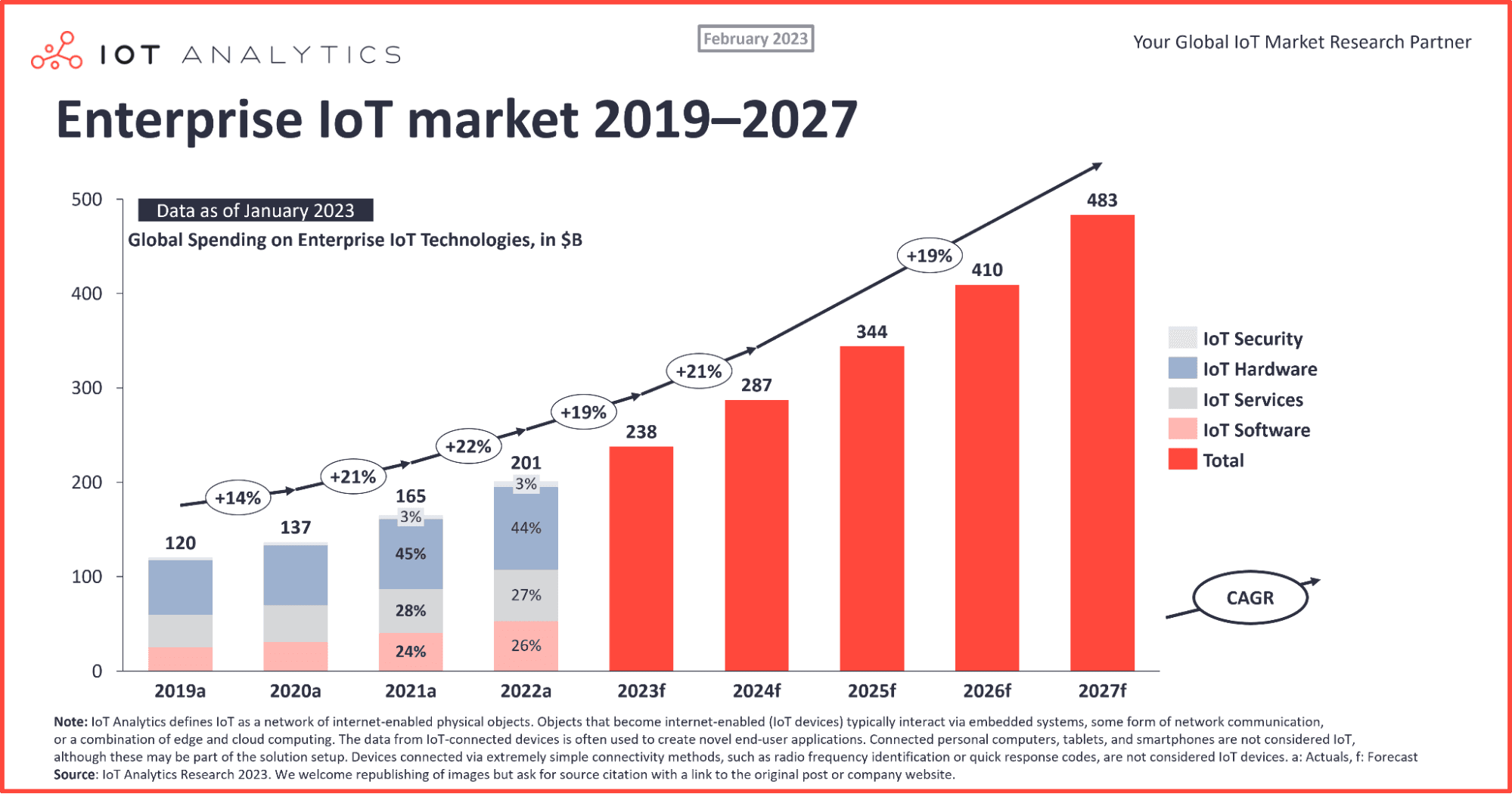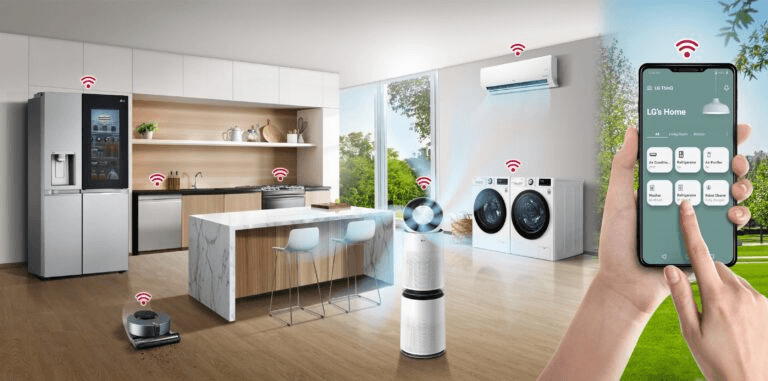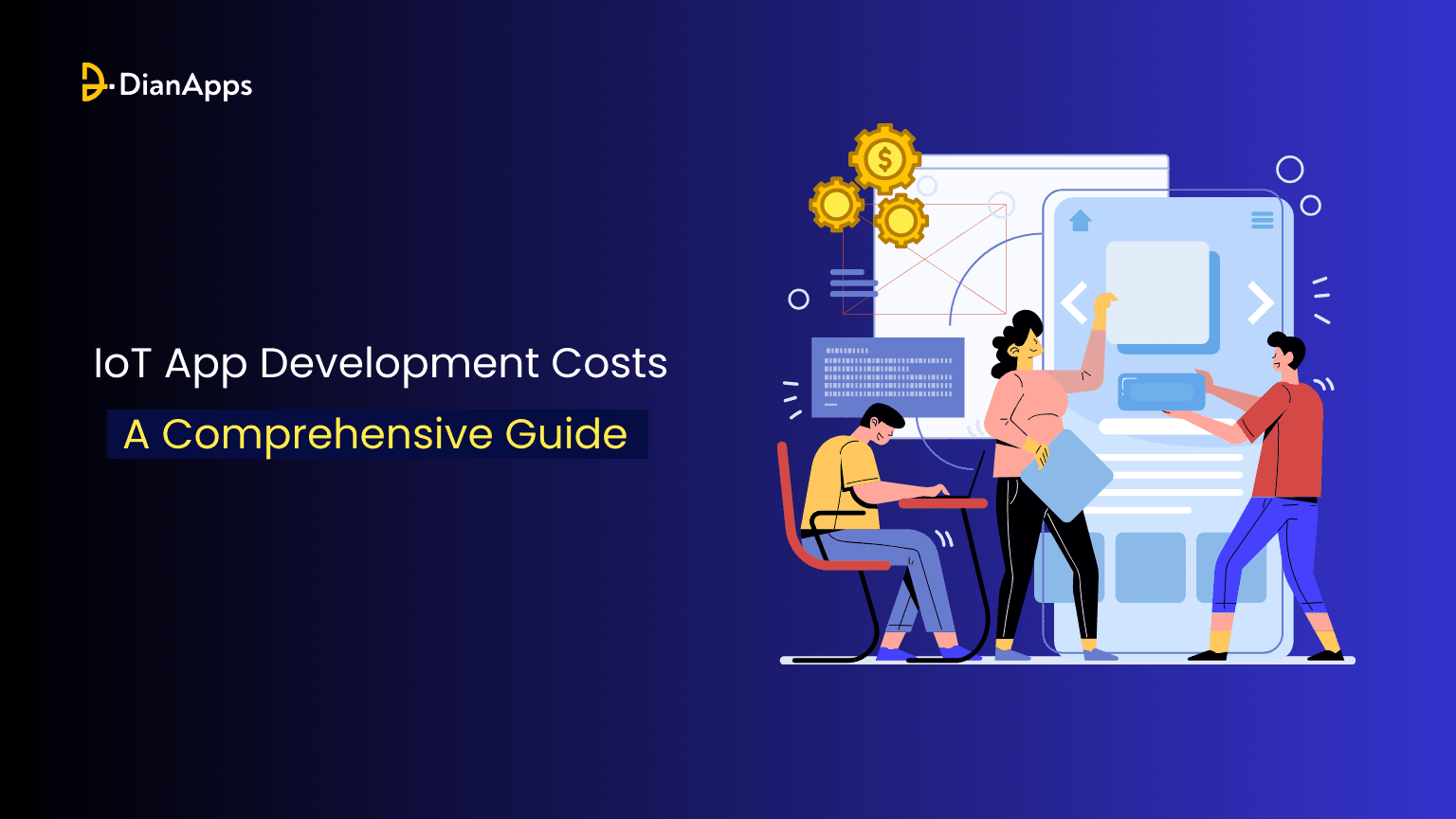The Internet of Things (IoT) has become an integral part of our lives, extending beyond smart homes and wearables. It’s now prevalent in retail, large-scale manufacturing, and finance. The demand for IoT mobile app development is on the rise, with an expected threefold increase in IoT devices globally by 2030, reaching 29 billion, as per Statista.
But what exactly is IoT, and why is it crucial in today’s digital market?
IoT involves a network of sensor-equipped objects that exchange information across compatible communication networks, software applications, and multiple devices. It enables control and interaction with machines and gadgets, fostering constant connectivity and resource interaction. As IoT applications become pervasive across industries, the world is increasingly reliant on this interconnected technology.
For businesses, investing in IoT app development is a strategic move to stay abreast of current trends and leverage emerging opportunities. This guide provides insights into the IoT application development process, covering costs, preferred tools, and implementation strategies for integrating a new app into your business.
Market Statistics of IoT Applications in 2024
- The global IoT market is set to experience a substantial revenue surge, reaching an impressive US$1,387.00 billion by 2024 worldwide.
- Anticipated to hit nearly 30 billion in 2030, IoT devices find applications across various verticals, spanning wearable devices, smart cars, homes, cities, and industrial equipment.
- Automotive IoT is expected to dominate, projecting a significant market volume of US$494.20 billion in 2024.
- The market is poised for a robust annual growth rate of 12.57% (CAGR 2024-2028), reaching an outstanding US$2,227.00 billion by 2028.
- On a global scale, the United States is predicted to lead, generating the highest revenue of US$199.00 billion in 2024.
- The commercialization of 5G has boosted connectivity, particularly in the automotive sector, driving the deployment of cellular IoT modules.
- With increased home automation through IoT, smart home device shipments are forecasted to reach 1.8 billion by 2025.
- In 2022, enterprise IoT spending witnessed a notable 21.5% growth, reaching $201 billion. IoT Analytics adjusted the growth outlook for 2023 to 18.5% (from 24% previously).

- IoT connections experienced a substantial increase from 2022 to 2023, with a rise of over 6 billion connections during this period, totaling 41.76 billion connections.
Having such a booming state and demand for IoT technology, many entrepreneurs are thinking for IoT app development for their businesses. But the primary concern is cost and time estimation.
So, let’s go through the cost of IoT app development services and the factors that drives it.
How much does it cost to develop an IoT app?
The cost of IoT application development may vary depending on its complexity that is decided on the basis of various features that will be added in the IoT app solution. The application that can be categorized as:

Moving ahead, the cost of developing an IoT Application also varies across countries, influenced by factors such as enterprise size, hourly developer rates, and geographical location. High development costs don’t always guarantee quality, and opting for lower-cost developers doesn’t ensure desired outcomes. Offshore development can be effective, offering reduced project timelines and cost advantages.
In North America, developing an IoT Application may range from $50 to $150 per hour, while in Eastern Europe, the standard cost is $30 to $50 per hour. In India, skilled developers can be found for $25 to $50 per hour. Considering these factors, the estimated total cost for an IoT Application depends on project size and features.
For a standard project with basic requirements, the cost may be around $18,000. A medium-sized project with some customization needs could range from $18,000 to $24,000. Complex projects may cost approximately $50,000 or above depending upon the specifications.
Major Factors Affecting IoT App Development Cost
Hardware
The cost of building a smart device constitutes 70-80% of the total development cost, varying based on the type and complexity of the IoT solution. Let’s delve into several stages of hardware design that impact the overall expense of constructing an IoT app.
- Initially, mobile app development companies engage in analysis, budget planning, concept development, and specification of technical requirements during this step.
- Moving on, the second stage involves modeling, where engineers collaborate with industrial designers to develop the interior elements of the device.
- The subsequent point covers prototyping, where developed PCBs undergo debugging and necessary modifications by the hardware device manufacturer.
- Finally, the last stage is testing, where successful prototypes proceed to the pre-production model. This phase includes various tests such as electrical safety, climatic assessments, user testing, and more.
Infrastructure
A crucial aspect of the infrastructure involves the development of maintenance support and monitoring systems for the entire IoT solution. This includes the software for remote device and network management. Given that ensuring constant and automated data security is the primary objective of IoT, it is essential to incorporate these systems for effective cost management.
The infrastructure comprises three distinct components, each playing a role in the cost of building an IoT solution:
Network
The IoT ecosystem cannot fulfill its purpose without a robust network infrastructure, featuring high scalability, high-speed connectivity, and low latency. IoT connectivity is predominantly facilitated by short-range wireless cellular and LPWAN solutions. When developing an IoT app from a system of connected devices operating over the cellular network, additional expenses are incurred.
Middleware
If you consider integrating ready-made third-party devices into the IoT ecosystem, you’ll require middleware – software that acts as an interface between two or more IoT components, connecting devices that may not communicate directly.
Cloud-based infrastructure
These encompass storage software and solutions that transform raw gigabytes of data into meaningful insights. Cloud computing solutions contribute significantly to the overall IoT app development cost. We recommend leveraging smart device connectivity and data analysis through PaaS solutions developed by industry leaders like Microsoft, Amazon, or Intel.
Application
An IoT application, can be categorized into three segments – Simple, Mediocre, and Complex – based on the level of development complexity. This factor directly influences the cost estimation for IoT app development platforms.
Simple:
These IoT apps operate alongside a custom tracker, requiring approximately 300 man-hours for development. Despite using sophisticated programming tools to render sensor data and provide real-time information, we label it as Simple because IoT development falling into this category requires less than 500 man-hours.
Medium-complex:
Apps falling into this category include BLE apps for managing connected devices, visualizing data, and sharing progress on social media. They typically require around 1000 man-hours for development, falling into a medium range of cost for IoT app development.
Complex:
This category includes secure iOS and Android mobile applications integrated with multiple radiation monitoring devices through Bluetooth. The app’s functionalities include generating reports, sending data to a cloud-based server, mandatory authorization, Pin code generation, etc. This level of development demands approximately 2000 man-hours.
Moreover, if you plan to incorporate AI into the collected data on the device or implement your IoT application on an enterprise level, the required resource allocation hours would only increase.
Magnitude of the team
In addition to the development phase, the professionals you choose from a mobile and web app development company also significantly impact the cost. Therefore, you can optimize the cost by selecting the right hiring model for your IoT applications.
Typically, you have three options to hire web developers: part-time, full-time, or on an hourly basis. Regardless of the model you choose, ensure that you seek assistance from a reputable mobile app development company in the USA or any other region.
Keep in mind that the development location will also play a role in determining the cost to build an IoT app, so consider this factor carefully.
Real-life examples of IoT Apps
AIRBIQUITY’S OTA software updates
Airbiquity is a tech company that offers services for connected cars, focusing on over-the-air (OTA) updates and data management. For users, it provides an option to automatically notify family or friends in case of a crash.
LG Electronics’ ThinQ appliances

LG provides a range of products, including home appliances, consumer electronics, and B2B solutions. They have introduced the ThinQ line of appliances that utilize machine learning and seamlessly connect with Google Assistant and Amazon Alexa. The ThinQ app allows users to connect to various devices, and these devices can send notifications when maintenance is required. The smart appliances offered by LG include refrigerators, washers, dryers, and ovens.
Wyze’s smart security cameras
Wyze creates a variety of IoT-controlled appliances to make it easier for people to manage their products. Their smart security cameras come in both wired and wireless options, connecting to other Wyze devices. This allows users to check video feeds even when they’re not at home.
Industry Verticals for IoT applications
Manufacturing
Integrating IoT in manufacturing optimizes processes by providing real-time monitoring. Combining IoT with AR enhances workers’ view of equipment conditions, fuel levels, and replacement parts.
Retail
IoT transforms retail with intelligent shopping, supply chain optimization, and personalized offerings based on location, pricing, and customer characteristics.
Smart cars
Connected cars with features like Wi-fi connectivity, location tracking, emergency dispatch, and remote functions are becoming prevalent, with an estimated 72.5 million connected cars by 2023.
Electronic healthcare
IoT applications in healthcare monitor patients, manage diagnostics, and analyze environmental conditions. Real-life example: Ochsner Health System integrates IoT to remotely monitor patients’ vitals, feeding data directly into medical records for remote tracking.
Smart supply chain
IoT drives innovation in the supply chain, improving operational efficiencies through asset tracking, vendor relations, inventory management, connected fleets, and scheduled maintenance. It also opens avenues for business expansion by providing transparency to buyers about the product’s journey.
Smart home
IoT applications in smart homes manage electricity, gas, water, and security systems, reducing the need for human intervention. Smart appliances detect movement, monitor light, set alarms, and enhance daily life.
The IoT industry extends beyond these six applications, and as its popularity grows, various platforms emerge to deploy applications that monitor and control connected devices and systems. Understanding the cost of IoT app development is essential in this dynamic market.
Why are IoT applications important for future?
If you are habitual of using voice assistants like Alexa, Siri, or Bixby in your smartphones, there’s no going back!
So, it’s already clear that, IoT applications have become an major part of our daily lives. This evolving technology is employed to simplify various aspects of people’s everyday routines, from ATMs and smart homes to energy management and numerous other hardware devices.
The Internet of Things is transforming our devices into tangible assets with a global reach. Presently, there are more communication devices than people, and the inclination to streamline our lives is undeniable. By 2025, we might find ourselves surrounded by a network of 21 billion interconnected gadgets. However, this is not the sole reason for its limelight.
The Internet of Things is poised to have a profound impact on the economy, revolutionizing businesses into remote operations, enabling new business models, enhancing efficiency, and broadening both employee and customer engagement. Enterprises stand to gain various advantages. The complexity of the Internet of Things is another contributing factor to its success.
Also read: IoT, Bots and Mobile Apps – A Victorious Trident for the Future
Our experience with IoT app development
Having explored all aspects, the next crucial step is to embark on your IoT journey. At DianApps, our IoT app developers understand business connectivity ecosystem. To ensure top-notch scalability, speed, and security, we provide a range of IoT app development services:
- IoT consultancy
- IoT app development
- IoT wearable connectivity development
- IoT testing and maintenance, and more
Execute your mobile app idea by reaching out to our team of expert from the renowned software development company, connecting you to the extremes of digital ecosystem.










Leave a Comment
Your email address will not be published. Required fields are marked *